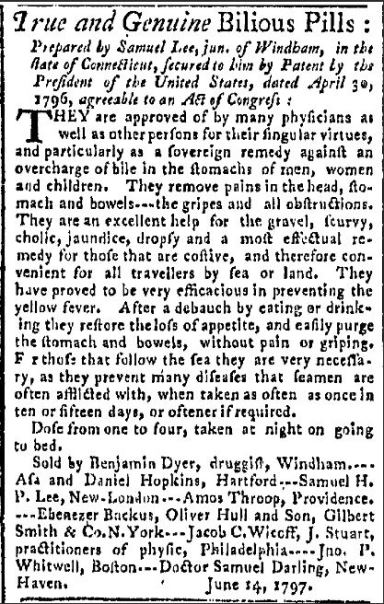On April 30, 1796, Samuel Lee Jr. of Windham, Connecticut, received a Letters Patent for his composition of bilious pills—a patent medicine that eventually became known as “Dr. Lee’s Windham Bilious Pills.” Lee’s patent was the first American patent for a pill of any kind as well as the first in its patent class.

An advertisement for Samuel Lee’s “True and Genuine Bilious Pills” from the Connecticut Journal, June 28, 1797
At the time Lee patented his pills, patent medicines imported from England were already common in America. Savvy entrepreneurs regularly created marketable medicines by mixing different combinations of extracts—but these compositions were not necessarily effective for treating the ailments they claimed to cure. The “True and Genuine Bilious Pills” prepared by Samuel Lee claimed to “remove pains in the head, stomach and bowels – – – the gripes and all obstructions.” They also were advertised as being an “excellent help for the gravel, scurvy, cholic, jaundice, dropsy . . . and therefore convenient for all travelers by sea or land.”
The success of a patent medicine was often linked to the reputation of its maker and Samuel Lee Jr. was the son of Dr. Samuel Lee, a respected local physician. Dr. Lee served as surgeon to the crew of the schooner Oliver Cromwell, which entered the privateer service in Norwich, Connecticut, during the Revolutionary War.
As Yankee peddlers spread their wares beyond New England, “Dr. Lee’s Windham Bilious Pills” soon appeared in stores up and down the East Coast. This success brought competition, however, and Samuel H. P. Lee, a druggist in New London, began selling a similar composition called “Lee’s New-London Bilious Pills.” Advertising from 1797 actually indicated that Samuel H. P. Lee had been an early distributor of Samuel Lee’s “True and Genuine Bilious Pills.” A very bitter pill for Samuel Lee Jr. to swallow, especially when Samuel H. P. Lee patented his own preparation in 1799 and marketed it under the name “Dr. Lee.” Both of these pills were the subject of additional patents and renewals and remained popular for years—possibly as a result of the very public feud that played out in newspaper advertising of the time:
A certain H. P. Lee, a young man, residing in New-London, has formed a Pill of a different composition, calling them “Lee’s New-London Bilious Pills,” which from the familiarity of names, may be passed off upon the public as the Pills of the present Patentee. It is therefore necessary to inform the public, that said Samuel H. P. Lee, of New -London, is no relation or connection of mine. – Samuel Lee Jr.








